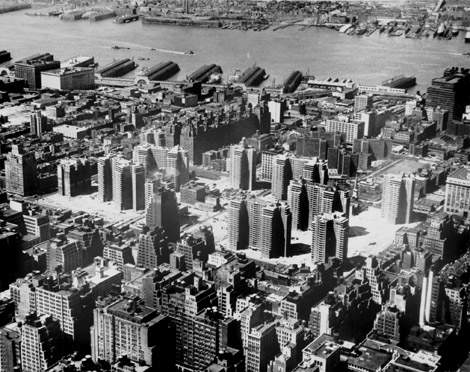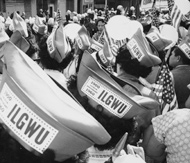

Highlights
ILGWU Cooperative Housing

Penn South: 50 Years of Affordable Housing
Sarah Rodriguez
Historically, affordable housing in New York City has always presented an issue for the working class. An influx of immigrants during the nineteenth century though, led to rapid urbanization and a shortage of dwellings that were both sanitary and affordable. The boom in population encouraged a growth in the construction of housing stock, which often led to the erection of questionable housing. These structures, called tenement buildings, often housed tens of people per room to maximize profit. They also lacked basic sanitary conditions with no light and no air and “open drains [which], only occasionally flushed, ran along both sides of the vaults of the buildings… and served as breeding ground for rats.”(1) Although building regulations had been established as far back as 1625 with “wooden chimney… prohibited… as a protection against fire hazards,” the lack of standards and the corruption of city officials made enforcing codes for sanitary, affordable housing an impossible task.(2) It wasn’t until 1867 that Manhattan passed the first Tenement House Law, a law limited to apartments that houses three or more families.
In the face of limited governmental enforcement, private citizens and organizations undertook the mission of creating affordable and sanitary housing conditions for the poor. Philanthropist groups undertook ownership of tenement buildings like Gotham Court, and attempted to reform them by offering “efficient management and individual concern.”(3) The rehabilitation of older tenant buildings proved too ineffective and the focus turned to “providing adequate new housing for the so-called laboring classes.”(4) Advocates of affordable housing pushed for the creation of new building typologies, such as the dumbbell model, which they hoped would provide an alternative to tenement buildings and offer sanitary dwellings, which could be constructed at an affordable price. It was a shift in sentiment from rehabilitation to demolition and construction that would dominate the planning landscape until the 1960’s.
Along with the creation of new typologies, the co-operative model was explored as an alternative form of affordable. Cooperatives had sprung up in England after the first modern cooperative had been established by the Rochdale Equitable Pioneers Society in England in 1844. It wasn’t until 1927, however, that the first housing cooperative was built in New York City by Abraham E. Kazan, with funding from the Amalgamated Clothing Workers of America. Inspired by the success of it and other housing cooperatives, Kazan established the United Housing Federation in 1951. The creation of the federation was dependent on three pieces of legislation. The first was the State Housing Law of 1926, the Redevelopment Companies Law passed in 1942, and the inclusion of Title 1 into the Federal Housing Act of 1951.
With the success of the East River Housing Cooperative, the International Ladies’ Garment Workers’ Union (ILGWU) president David Dubinsky, who had major aspirations for the ILGWU, readily agreed to take on the lion’s share of funding for the Mutual Redevelopment Houses, Penn South Cooperative or, as they came to be known, Penn South. Both sides agreed that “it should be built on the West Side of Manhattan rather than on the East side, since the majority of the garment shops [were] on the West Side.”(5) To fund the project, Dubinsky borrowed from the pensions of various ILGWU locals. It was a move that was with met with resistance.
Although discussion of plans for an ILGWU sponsored housing project began in June 1956, official work on the ILGWU Houses project began in 1957, just as the Seward Park Cooperative was beginning construction. Kazan and Robert Szolds carried out the application for incorporation on May 16th. From inception, the project met with opposition from the local community. The board members for the fledging corporation were composed of Luigi Antonini, George J. Mintzer, Isidore Nagler, Robert Szold, Harry Uviller, Charles S. Zimmerman, and Kazan, all of whom except for Kazan and Szold had worked for the ILGWU. At the time of incorporation, Antonini served as vice president, while Zimmerman managed Local 22. Nagler had previously worked in the union as the manager for Local 10 for over 10 years, while Mintzer had served as an Impartial Chairman. The corporation, itself, was tentatively named the "International Union Houses, Inc.," a named which was later changed to the Mutual Redevelopment Houses, Inc., at the request of the ILGWU to lower its liability.
By 1958 approximately 3600 people had applied and paid a down payment of 500 dollars apiece. After attempting to secure funding from several different financial institutions, money for the permanent and construction loans was secured by 1960 from the New York State Teachers Retirement Fund, the Dry Dock Savings Bank, the Chemical Bank New York Trust Company and Manufacturers Trust, and of course the ILGWU. Further funding was requested in April 1962 from the ILGWU, to include air-cooling in the project; making it one of the first cooperatives to include an air-cooling system. Along with air-cooling, the project continued to face several, unplanned financial setbacks. Due to numerous raises in taxes implemented by the city, and with strikes by the concrete drivers and electrical workers, the project had to more than double its monthly rent and carrying charges, push back of the amortizations dates, and apply for increases in the mortgage.
In spite of the setbacks, Penn South was dedicated on May 19, 1962; five days after tenants had begun to take up residence. In attendance were Eleanor Roosevelt, Governor Nelson A. Rockefeller, ILGWU President David Dubinsky, urban planner Robert Moses, and President John F. Kennedy. Unfortunately, the cooperative continued to experience funding issues. Commercial space was only half full and brought in little more than half of its expected revenue. Fortunately, the commercial spaces that were filled contained stores that catered to tenants’ daily necessities. The power plant caught fire on March 14, 1963 and shut down the entire electrical system. Elevators continued to break down, forcing the project to bring in the Westinghouse Electrical Company and the Herk Elevator Company to study the problem. Air-cooling in building four was lost during April 1966, on the hottest day of the year. To combat the several issues faced, different committees were formed early on, all of whom reported to the board of directors. Even with the cost of repairs, in the 1970’s during New York City’s financial crisis, Penn South paid its taxes early.
The 1980’s saw an increase of different tenant activities and clubs, some of which helped to provide the senior citizens of the cooperative with necessary services. In 1986 to make necessary repairs and to refinance the mortgage, the Penn South cooperative took on a loan from the National Cooperative Bank, and because it was federally sponsored was able to bypass city and state taxes, offering a rate that was lower by two to two and half percent than private banks. A year later, in late October, the cooperative voted on whether to apply to the city for twenty-five years’ worth of tax abatement; it was the first of many votes, and one which would set the tone for further discussions surrounding affordability. The vote passed and on March 6th the MRH board sent in an application to the New York City Department of Housing Preservation and Development. The application was approved merely two months later, allowing the project to retain its non-profit status.
The 1990's saw major changes to the housing project with, among other things, the election of the first new president in over 21 years. Jeff Dullea, who served as president from 1993 to 1997, focused on community. Under his appointment the project opened a Youth Recreation Room, designated space behind building seven for the active recreation of children of tenant-cooperators, and replaced the windows with double panel thermal windows. Robert Silverstein, who served from 1997 to 2004, oversaw the negotiation of a new contract with the city. The contract gave the project “shelter rent tax” status, allowing the property tax assessment to be based on rent rather than the assessed value of the property. The contract, which was voted for by over eighty percent of the cooperative, allowed the housing project to extend its tax abatement to 2022. Silverstein's successor, Irma Lobal, the first female president of the cooperative, continued to work with the city to renegotiate the terms of the contract, allowing the project to raise funds for major improvements. To do this, equity was doubled on the first sale of apartments “with the proviso that half of the equity would be deposited in a capital improvement fund for the future.”(6) Elevator modifications were also made to eliminate skip stops. Morris Benjamin, the current president, who began his tenure in 2006, implemented further renovation projects. Talk about a plan to replace the development's entire heating and cooling system (HVAC) started in 2009, and in 2011, the city helped to provide further funding for the project in exchange for the cooperative voting favorably to extend the tax abatement to 2030. Over 85 percent of the cooperative voted to keep the cooperatives limited equity status, continuing a history of over 50 years’ worth of affordability. The rest of the funding was provided by the AFL-CIO Housing Investment Trust. Even though it has continued to keep its affordability status, Penn South faces many challenges, such as the inflation of surrounding neighborhoods in Chelsea and changes in demographics both of which have run the risk of turning Penn South into a market rate cooperative. Yet in the face of such pressures, Penn South residents have continued to vote on their idealism, preserving the affordability of the housing project for the next generation to come.
(1) Anthony Jackson, A Place Called Home, (Cambridge: MIT Press, 1976), 7.
(2) Ira S. Robbins and Marian Sameth, ed., Directory of Large Scale Rental and Cooperative Housing with a Summary of Legislation relating to housing and Urban Renewal in New York City, (New York City: Citizen’s Housing and Planning Council of New York, Inc.,1957), 5.
(3) Ibid
(4) Anthony Jackson, A Place Called Home, (Cambridge: MIT Press, 1976), 10.
(5) Lloyd Kaplan, “Reminiscences of Abraham Kazan; oral history 1968,” (1968).
(6) Morris Benjamin et al., Penn South 50th Anniversary, (New York City, 2012), 9.
Archival Collections
5780 Pubs ILGWU Publications: Box 66, folder 5-6
5780/004 Louis Stulberg, General Secretary-Treasurer Correspondence: Box 32, folder 1-2
5780/063 Legal Department Records: Box 1, folders 2, 15, 17
5780/083 Sol Chaikin Papers: Box 34, folder 64
5780/187 Irwin Solomon Papers: Box 80, folder 1
5780/203 Jay Mazur Papers: Box 20, folder 18
About the Author
Sarah Rodriguez received her M.A. in Architecture Planning Preservation from Cornell University in 2013. Her thesis entitled "Penn South: How Concrete and the Super-block Created a Community Based on Affordable Housing" traces the history of Penn South through personal accounts, literature, and primary sources from the ILGWU archives.
Photographs
David Dubinsky and the United Housing Foundation
President John F. Kennedy speaking at the dedication ceremony
Aerial view of Penn South
Eleanor Roosevelt, John F. Kennedy, and Lyndon B. Johnson at the dedication ceremony
David Dubinsky addresses a crowd at the dedication
John F. Kennedy and David Dubinsky at the dedication
Housing application office


